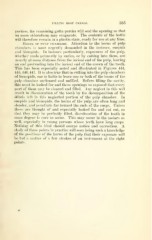Page 739 - My FlipBook
P. 739
FILLING ROOT CANALS. 385
portion, the remaining gutta-percha will seal the opening so that
no more chloroform may evaporate. The contents of the bottle
will therefore remain in a plastic state, ready for use at any time.
Horns of pulp chambers. Attention to the horns of pulp
chambers is most urgently demanded in the incisors, cuspids
and bicuspids. In incisors particularly, exposures of the pulp,
whether made primarily by caries, or by cutting into them, are
usuallj^ at some distance from the incisal end of the pulp, leaving
an end protruding into the incisal end of the crown of the tooth.
This has been especially noted and illustrated in Figures 444,
445, 446, 447. It is also true that in cutting into the pulp chambers
of bicuspids, one is liable to leave one or both of the horns of the
pulp chamber nncleaned and unfilled. Before filling the cavity,
this must be looked for and these openings so exposed that every
part of them may be cleaned and filled. Any neglect in this will
result in discoloration of the tooth by the decomposition of the
debris left in this neglected portion of the pulp chamber. In
cuspids and bicuspids, the horns of the pulp are often long and
slender, and penetrate far toward the ends of the cusps. Unless
these are thought of and especially looked for and cut out, so
that they may be perfectly filled, discoloration of the tooth in
some degree is sure to occur. This may occur in the molars as
well, especially in young persons whose teeth have long cusps
Nothing of this kind should esca]ie notice and correction. A
study of these points in practice will soon bring such a knowledge
of the positions of the horns of the pulp that their exposure will
be but a matter of a few strokes of an instrument at the right
points.
47


